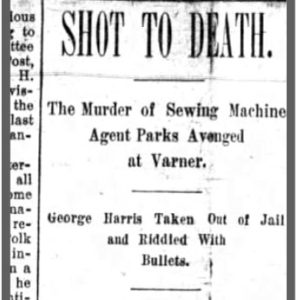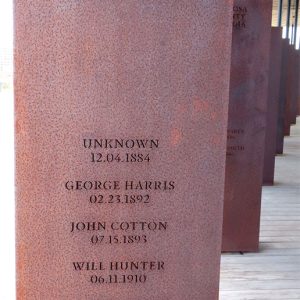calsfoundation@cals.org
George Harris (Lynching of)
On February 23, 1892, an African-American man named George Harris was lynched by a mob near Varner (Lincoln County) for allegedly murdering E. F. Parker (sometimes referred to as S. F. Parker) the previous September.
According to newspaper accounts, Parker was a “peaceable and inoffensive citizen of Lincoln County.” He had previously lived in Drew County, where he married Mary McCloy of Monticello in 1882. There is no official record of a man named George Harris in either Lincoln or Drew counties, but the Arkansas Democrat noted that he had formerly lived on Steve Gaster’s plantation in Drew County. At the time of the 1880 census, there was a Steve Gaster living in Ferguson (Drew County) with his mother-in-law, Rachel Bussell, and his wife, Mollie Gaster.
Apparently in late August 1891, Parker had gone to Harris’s home in Tyro (Lincoln County) and sold Harris a sewing machine, with a horse as security. When he returned a week or so later (probably September 9) to “have the mortgage signed up,” Mrs. Harris said that the horse belonged to her and that she did not want to close the deal. In place of the horse, some cattle were substituted as surety. Mrs. Harris asked Parker to show her how to use the machine, and when he was finished he turned to leave the house. George Harris sneaked up on him as he was leaving and stabbed him. According to a report published the following February in the Arkansas Gazette, Harris had also planned to rob Parker, and all of Parker’s valuables were missing when he was found. Harris then went back into the house and told his wife what he had done and placed the blame on her. He then stabbed her, probably mortally. Parker lived for a short time and was able to tell authorities what had happened. Harris fled into the cane, followed by a posse. When they fired at him, he surrendered and was jailed in Varner to await trial the following February.
At 2:00 a.m. on February 23, 1892, a mob of seventy-five armed masked men (a later article in the Gazette put the number between twenty-five and forty), fearing that Harris would escape, approached the jail. According to the Arkansas Gazette, they came to the deputy’s room in the jail and demanded the keys. The deputy tried to reason with them, urging them to “let the law take its course.” When they forcibly demanded the keys, he surrendered them. They then took Harris from his cell, and he supposedly confessed to the crime, saying that Parker had “insulted his wife.” The mob riddled Harris’s body with bullets (a February 26, 1892, article in the Gazette reported that they “lodged bullets enough in him to have killed him twenty times”) and rode away in the direction of Drew County.
A Judge Elliott assembled a grand jury and charged them with investigating the lynching “and bring[ing] members of the mob to justice if possible,” although he conceded that since those in the mob were all masked, identification would be difficult. On February 26, the Gazette printed excerpts from the grand jury’s finding: “After a most thorough and rigid examination, we are convinced that no citizen of this district or county, participated, either directly or indirectly in the terrible outrage committed here on the night of the 22d of February [actually early on the morning of February 23]. Our citizens are indignant that a mob of disguised ruffians should invade her territory for the purpose of assassination.” The Gazette went on to decry the use of mob violence: “Considering the law abiding habits of our people, and the prompt enforcement of the law by the judiciary, it seems, to a candid mind, that resort to criminal revolution is not in any sense right, but sometimes crimes exhibit such enormities, that to await their punishment by the slow, but necessary routing of the law, is more than an outraged community will brook.” The writer conceded that this was “one of those outbursts that no good government could prevent.”
For additional information:
“Double Murder.” Arkansas Democrat, September 11, 1891, p. 1.
“Mob Violence.” Arkansas Gazette, February 26, 1892, p. 3.
“Shot to Death.” Arkansas Gazette, February 24, 1892, p. 1.
Nancy Snell Griffith
Davidson, North Carolina
 Civil Rights and Social Change
Civil Rights and Social Change Post-Reconstruction through the Gilded Age, 1875 through 1900
Post-Reconstruction through the Gilded Age, 1875 through 1900 George Harris Lynching Article
George Harris Lynching Article  Lincoln County Lynching
Lincoln County Lynching 




Comments
No comments on this entry yet.